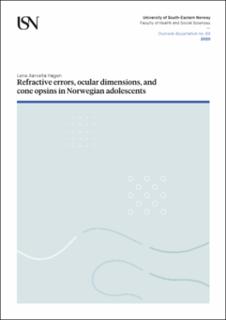| dc.contributor.author | Hagen, Lene Aarvelta | |
| dc.date.accessioned | 2020-05-10T21:08:42Z | |
| dc.date.available | 2020-05-10T21:08:42Z | |
| dc.date.issued | 2020-05-20 | |
| dc.identifier.isbn | 978-82-7206-555-2 | |
| dc.identifier.issn | 2535-5252 | |
| dc.identifier.uri | https://hdl.handle.net/11250/2653756 | |
| dc.description.abstract | The worldwide increase in myopia prevalence is of concern since the ocular elongation raises the risk of secondary ocular pathology. In order to establish effective myopia prevention strategies, a deeper knowledge of the mechanism underlying refractive error development is needed. Refractive errors are the result of a highly complex process of ocular growth; influenced by environmental factors and with a genetic predisposition. The ocular growth is primarily regulated by visual signals, initiated by light absorption in the long (L), middle (M), and short (S) wavelength sensitive cones on the retina. The aim of this thesis was to explore and describe refractive errors, ocular dimensions, and whether myopia was associated with L:M cone ratios and heterozygosity/homozygosity of common L or M cone opsin exon 3 haplotypes in adolescents in Norway.
A cross-sectional study was conducted in a representative sample of Norwegian 16–19-year-olds. Cycloplegic autorefraction and ocular biometry were measured, L and M cone opsin genes were analysed, and individual L:M cone ratios were estimated. After 2 years, cycloplegic autorefraction and ocular biometry measurements were repeated in a subsample. The myopia prevalence was low in the Norwegian adolescents, even though they have few daylight hours available in the autumn-winter period and are in a highperforming education system. Emmetropes/low-hyperopes exhibited coordinated ocular growth at 18 years of age. Myopia was found to be associated with both low L:M cone ratios and heterozygosity of common L cone opsin exon 3 haplotypes in females.
The results indicated a well-adapted emmetropisation mechanism in the Norwegian adolescents and suggested that a low genetic predisposition protected this population from myopia. Individual differences in L:M cone ratios and common L cone opsin polymorphism may be of importance for personalised myopia prevention and management strategies. | en_US |
| dc.language.iso | eng | en_US |
| dc.publisher | University of South-Eastern Norway | en_US |
| dc.relation.haspart | Paper I: Hagen, L.A., Gjelle, J.V.B., Arnegard, S., Pedersen, H.R., Gilson, S.J. & Baraas, R.C.: Prevalence and Possible Factors of Myopia in Norwegian Adolescents. Scientific Reports, 8(1), 13479, (2018). https://doi.org/10.1038/s41598-018-31790-y | en_US |
| dc.relation.haspart | Paper II: Hagen, L.A., Gilson, S.J., Akram, M.N. & Baraas, R.C.: Emmetropia Is Maintained Despite Continued Eye Growth From 16 to 18 Years of Age. Investigative Ophthalmology and Visual Science, 60(13), 4178-4186, (2019). https://dx.doi.org/10.1167/iovs.19-27289 | en_US |
| dc.relation.haspart | Paper III: Hagen, L.A., Arnegard, S., Kuchenbecker, J.A., Gilson, S.J., Neitz, M., Neitz, J. & Baraas, R.C.: The association between L:M cone ratio, cone opsin genes and myopia susceptibility. Vision Research, 162, 20-28, (2019). https://dx.doi.org/10.1016/j.visres.2019.06.006 | en_US |
| dc.rights | Navngivelse-Ikkekommersiell-DelPåSammeVilkår 4.0 Internasjonal | * |
| dc.rights.uri | http://creativecommons.org/licenses/by-nc-sa/4.0/deed.no | * |
| dc.subject | refractive error | en_US |
| dc.subject | myopia | en_US |
| dc.subject | hyperopia | en_US |
| dc.subject | ocular dimensions | en_US |
| dc.subject | ocular axial length | en_US |
| dc.subject | crystalline lens | en_US |
| dc.subject | cone opsin | en_US |
| dc.subject | cone opsin exon 3 haplotype | en_US |
| dc.subject | L:M cone ratio | en_US |
| dc.subject | person-centred eye-care | en_US |
| dc.title | Refractive errors, ocular dimensions, and cone opsins in Norwegian adolescents | en_US |
| dc.type | Doctoral thesis | en_US |
| dc.description.version | publishedVersion | en_US |
| dc.rights.holder | © 2020 Lene Aarvelta Hagen, except otherwise stated | en_US |
| dc.subject.nsi | VDP::Medisinske Fag: 700::Klinisk medisinske fag: 750::Oftalmologi: 754 | en_US |

